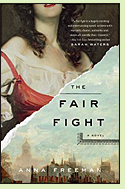The Fair Fight
by Anna Freeman
Reviewed by Margaret Tomlinson

The Fair Fight is about an eighteenth-century female prizefighter. Ruth may be fictional, but there were indeed female prizefighters in eighteenth-century England, and her life is imagined with such meticulous faithfulness to the historical setting that it's easy to believe it might have unfolded in just this way. In the eighteenth-century, the sport was much cruder than today's boxing matches. Men and women fought with only a few layers of cloth wrapped around their hands. Few if any rules protected the lives and health of the fighters, who might be maimed for life or lose eyes or even their lives.
While the novel doesn't flinch from the sport's physical brutality, the emphasis is overwhelmingly on the social brutalities of the time, especially those affecting the lives of women. Ruth, born in a brothel and not attractive enough to become a successful prostitute, is always central to the story. Another well-drawn character, the aristocratic Charlotte, serves as Ruth's counterpoint. Marked by smallpox and effectively the prisoner of her unhappy and spiteful brother, she seems to have even fewer options in life than Ruth.
Though two men in the story prove admirable, much of the middle section is devoted to the stories of three men almost devoid of redeeming qualities, and the novel sags a bit as it focuses on these men. Ruth and Charlotte, though, will be enough to keep plenty of readers hooked to the last page. Flawed enough to feel real, sympathetic enough to care about, and with courage enough to face the tremendous obstacles eighteenth-century life could dish out to women, they make the rest of The Fair Fight a page-turner. (2014, 474 pages including an Author's Note separating fact from fiction)
More about The Fair Fight at Powell's Books or Amazon.comAnother novels about prizefighting:
The Abysmal Brute by Jack London (1913), about a boxer who discovers corruption in the way the sport is managed. More info
Nonfiction about prizefighting:
She's a Knockout! A History of Women in Fighting Sports by L.A. Jennings (2015), includes biographical information on the eighteenth-century English prizefighter Elizabeth Wilkinson Stokes. More info
Strange Encounters: Tales of Famous Fights and Famous Fighters - A Complete History of Bareknuckle Pugilism and Boxing by James Brady (1946), an illustrated history of bareknuckle pugilism in England, with accounts of famous fights. More info
On Boxing by Joyce Carol Oates (1987), essays about boxing. More info
Online:
Elizabeth Stokes, Lady Bare-Knuckles, at the Georgian London blog
Back to Novels of the Eighteenth Century
Back to Directory of Book Reviews